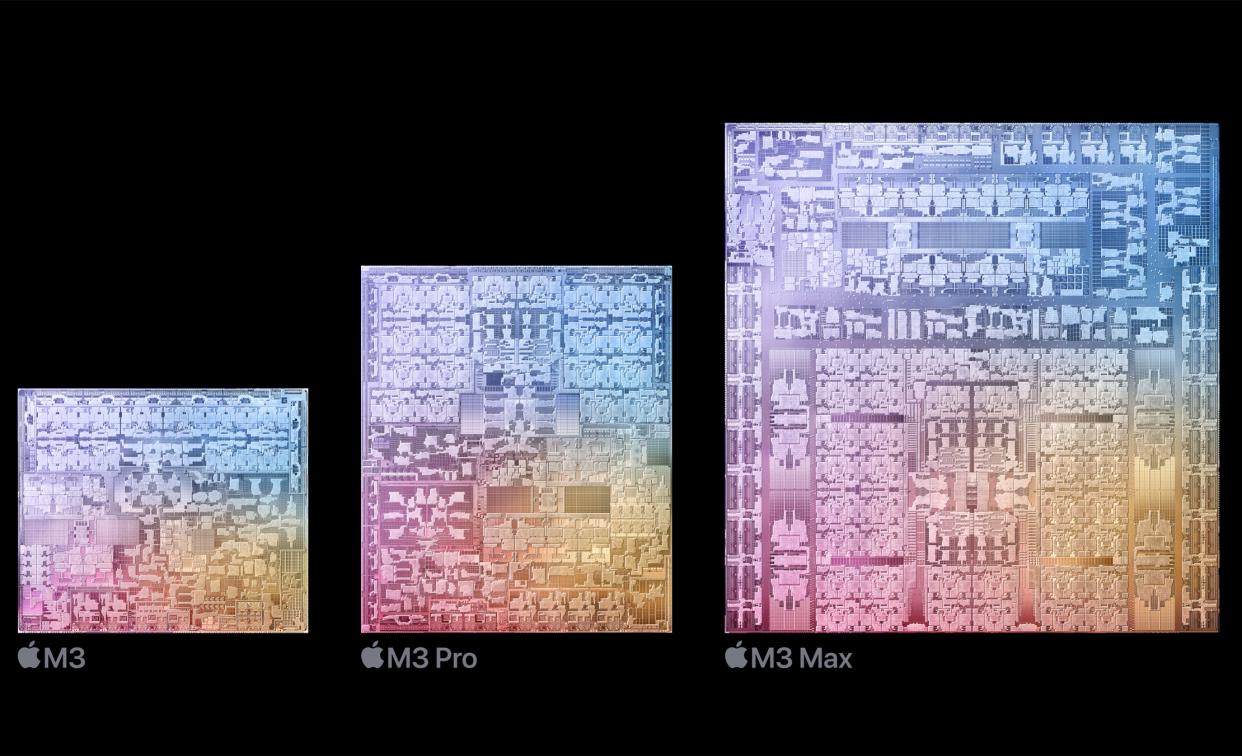Apple debuts M3 chips as processor competition grows
Apple (AAPL) is getting in on the Halloween spirit a bit early, debuting a trio of new custom chips for its Mac line of laptops and desktops during its “Scary Fast” event on Monday. The M3, M3 Pro, and M3 Max are, as you likely guessed, Apple’s third generation of processors for its Macs and, the company promises, its most advanced to date.
The first 3-nanometer consumer computer chips, Apple says its Arm-based (ARM) M3 line packs 2 million transistors into a space as small as the cross section of a human hair. The more transistors a chip can cram into a smaller space, the better the overall performance.
According to the tech giant, the M3 lineup’s CPU (central processing unit) performance cores are 30% faster than the M1’s performance cores, while its efficiency cores are 50% faster. Performance cores are designed to handle more processor-intensive tasks, while efficiency cores take care of menial tasks.
The M3 chips also get an improved neural engine that’s 60% faster than the one found in the M1, something that’s becoming increasingly important as AI permeates more of the software and apps we use on a daily basis.
But the biggest changes, and the ones Apple is leaning most heavily on with the M3 launch, are the chips’ GPUs (graphics processing units). Apple says the chips’ GPUs offer a new feature called Dynamic Caching, which is a unique way of allocating memory for graphics-heavy operations.
The idea is to ensure the software you’re using is getting the most out of the GPU’s available resources. The company says the feature will dramatically improve performance across graphics-intensive apps and games.
The M3’s GPUs also now include hardware-accelerated ray tracing, which improves how light interacts with scenes in games and apps to create more realistic images. Overall, Apple says the M3’s GPUs can deliver the same performance as the M1 while using almost half of the power, and, when pushed, put out 65% more performance at its peak.

The base M3 features an 8-core CPU and 10-core GPU, sports a whopping 25 billion transistors, and can be outfitted with up to 24GB of memory. Apple uses what’s called unified memory, which means the CPU and GPU share a single pool of memory.
The M3 Pro is for consumers and semi-professionals who need a bigger performance boost to handle everything from photo and video editing to architectural renderings and business apps. It comes with 37 billion transistors, a 12-core CPU, 18-core GPU, and up to 36GB of memory.
At the top of the line is the M3 Max, which has 92 billion transistors, 16 CPU cores, 40 GPU cores, and up to 128GB of memory. This is the chip you’d get if you’re doing serious 3D animation, working with CAD files, or working with large language models.
Competition is ramping up
Apple designs its chips as a means of differentiating the company’s computers from Windows-based systems and Chromebooks. By controlling the chips, hardware, and software that power its laptops and desktops, Apple is able to exert a level of control other companies simply can’t match.
And while the Cupertino, Calif.-based company has only been putting its own chips in its laptops and desktops for three years, Apple has been designing its iPhone chips for years. That expertise has translated into some impressive performance gains over the years while improving overall battery life. Apple says MacBooks with M3 chips can get up to 22 hours of battery life.
But competition is stirring in the chip space from the likes of Qualcomm (QCOM) and, reportedly, Nvidia (NVDA). Last week, Qualcomm debuted its new Snapdragon X Elite chip, which the company says matches the power of Apple’s M2 Max, while using less power.
Qualcomm’s Arm-based chip will only be found in Windows systems. And while that means there’s no direct competition between that company’s chips and Apple’s, if Qualcomm’s offering lives up to its claims, the chip could serve as a catalyst to convince consumers who were thinking of buying a Mac to buy a Windows-based machine instead.
It’s not just Qualcomm gunning for Apple’s power versus performance capabilities. According to Reuters, Nvidia is also working on its own Arm-based chip that could rival Apple’s processors.
All of this also spells trouble for Intel (INTC), which needs consumers to buy Windows-based systems that use its chips to ensure it holds on to its share of the CPU market. According to IDC, 64% of the new consumer PC shipments had Intel chips in 2022. But as competitors continue to roll out new, intriguing chip options, Intel’s job could become more difficult.
Still, with chips like the M3 line hitting the market, and clear signs that Apple will continue releasing new processors on a yearly cadence, it could take some time before the competition catches up.
Daniel Howley is the tech editor at Yahoo Finance. He's been covering the tech industry since 2011. You can follow him on Twitter @DanielHowley.
Click here for the latest technology news that will impact the stock market.
Read the latest financial and business news from Yahoo Finance

